ACC200: Job Order Costing, Turramurra Furniture Co. - WIP & Overhead
VerifiedAdded on 2024/04/26
|12
|1529
|440
Report
AI Summary
This report provides a detailed analysis of Turramurra Furniture Company's job order costing system. It includes calculations for work-in-process (WIP) inventory as of June 30, 2017, and the cost of chairs in finished goods inventory for the same period. The report also calculates the over or under applied overhead for the year, discusses the treatment of over applied overhead, and suggests an approach for handling material over applied overhead. Furthermore, it explores the potential benefits of using activity-based costing (ABC) for expanding the company's product range, arguing that ABC offers advantages over the traditional job order costing method by allocating costs based on cost drivers rather than machine hours. The report concludes that implementing ABC could improve activity planning, control processes, and capacity utilization within the company.

ACC200
1.
1
1.
1
Paraphrase This Document
Need a fresh take? Get an instant paraphrase of this document with our AI Paraphraser
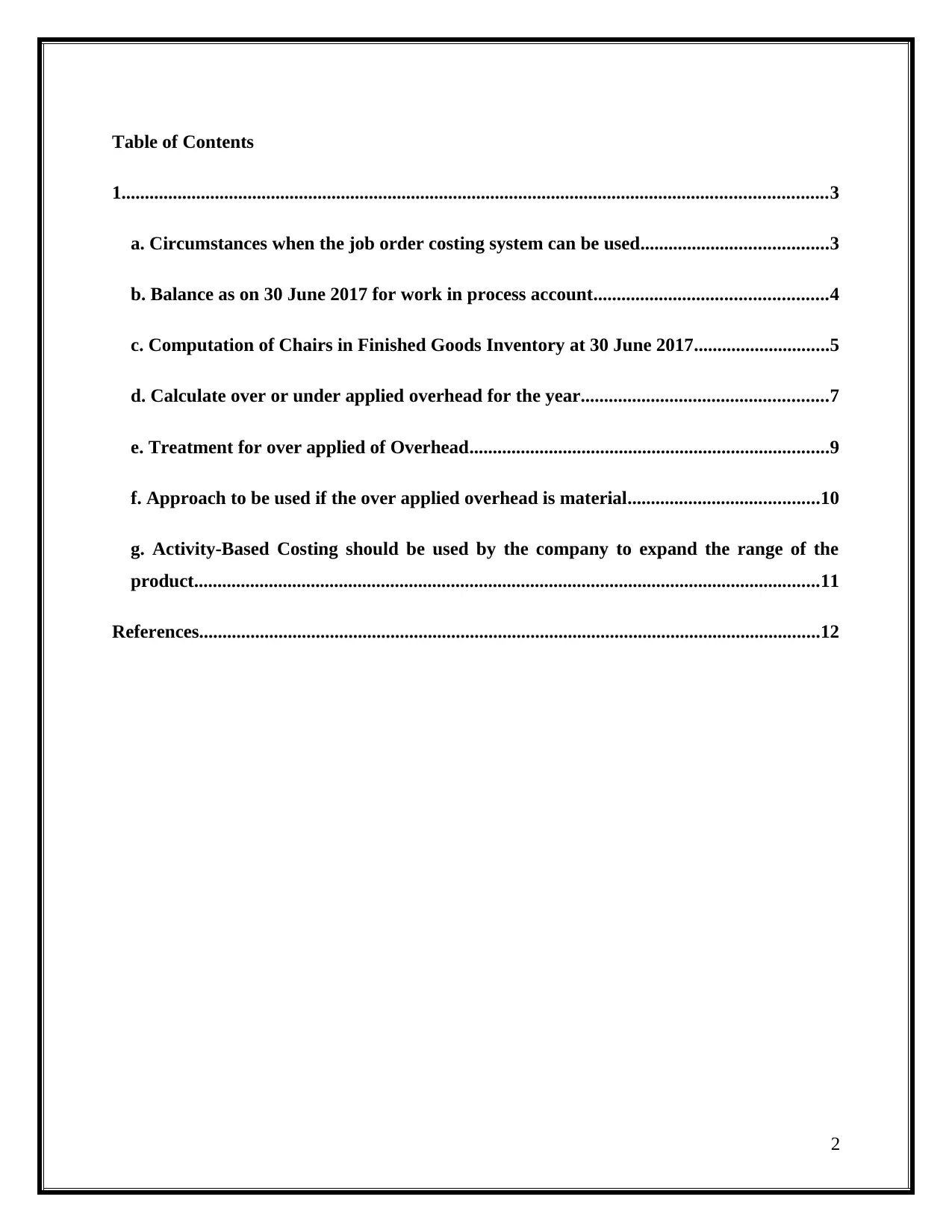
Table of Contents
1.......................................................................................................................................................3
a. Circumstances when the job order costing system can be used........................................3
b. Balance as on 30 June 2017 for work in process account..................................................4
c. Computation of Chairs in Finished Goods Inventory at 30 June 2017.............................5
d. Calculate over or under applied overhead for the year.....................................................7
e. Treatment for over applied of Overhead.............................................................................9
f. Approach to be used if the over applied overhead is material.........................................10
g. Activity-Based Costing should be used by the company to expand the range of the
product......................................................................................................................................11
References.....................................................................................................................................12
2
1.......................................................................................................................................................3
a. Circumstances when the job order costing system can be used........................................3
b. Balance as on 30 June 2017 for work in process account..................................................4
c. Computation of Chairs in Finished Goods Inventory at 30 June 2017.............................5
d. Calculate over or under applied overhead for the year.....................................................7
e. Treatment for over applied of Overhead.............................................................................9
f. Approach to be used if the over applied overhead is material.........................................10
g. Activity-Based Costing should be used by the company to expand the range of the
product......................................................................................................................................11
References.....................................................................................................................................12
2
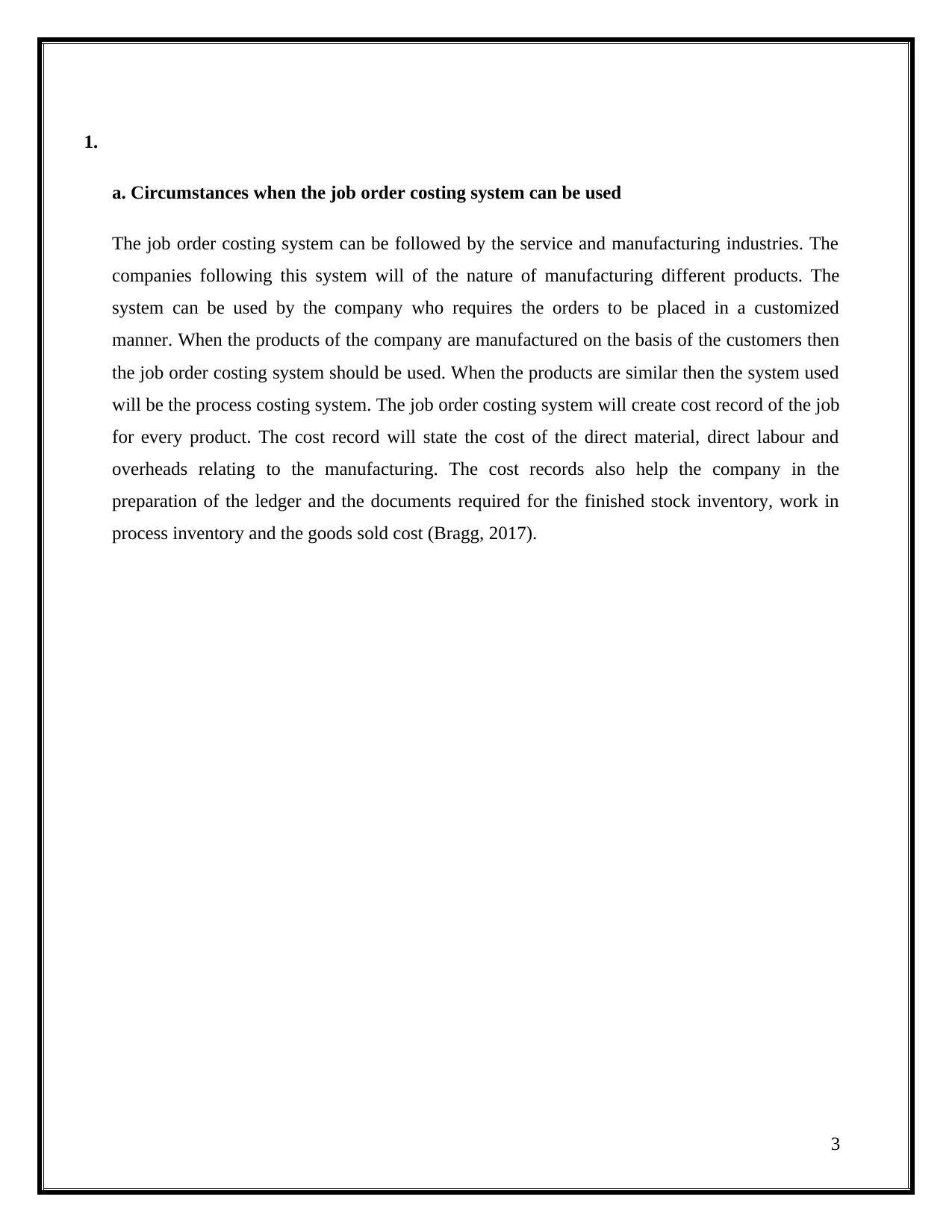
1.
a. Circumstances when the job order costing system can be used
The job order costing system can be followed by the service and manufacturing industries. The
companies following this system will of the nature of manufacturing different products. The
system can be used by the company who requires the orders to be placed in a customized
manner. When the products of the company are manufactured on the basis of the customers then
the job order costing system should be used. When the products are similar then the system used
will be the process costing system. The job order costing system will create cost record of the job
for every product. The cost record will state the cost of the direct material, direct labour and
overheads relating to the manufacturing. The cost records also help the company in the
preparation of the ledger and the documents required for the finished stock inventory, work in
process inventory and the goods sold cost (Bragg, 2017).
3
a. Circumstances when the job order costing system can be used
The job order costing system can be followed by the service and manufacturing industries. The
companies following this system will of the nature of manufacturing different products. The
system can be used by the company who requires the orders to be placed in a customized
manner. When the products of the company are manufactured on the basis of the customers then
the job order costing system should be used. When the products are similar then the system used
will be the process costing system. The job order costing system will create cost record of the job
for every product. The cost record will state the cost of the direct material, direct labour and
overheads relating to the manufacturing. The cost records also help the company in the
preparation of the ledger and the documents required for the finished stock inventory, work in
process inventory and the goods sold cost (Bragg, 2017).
3
⊘ This is a preview!⊘
Do you want full access?
Subscribe today to unlock all pages.

Trusted by 1+ million students worldwide
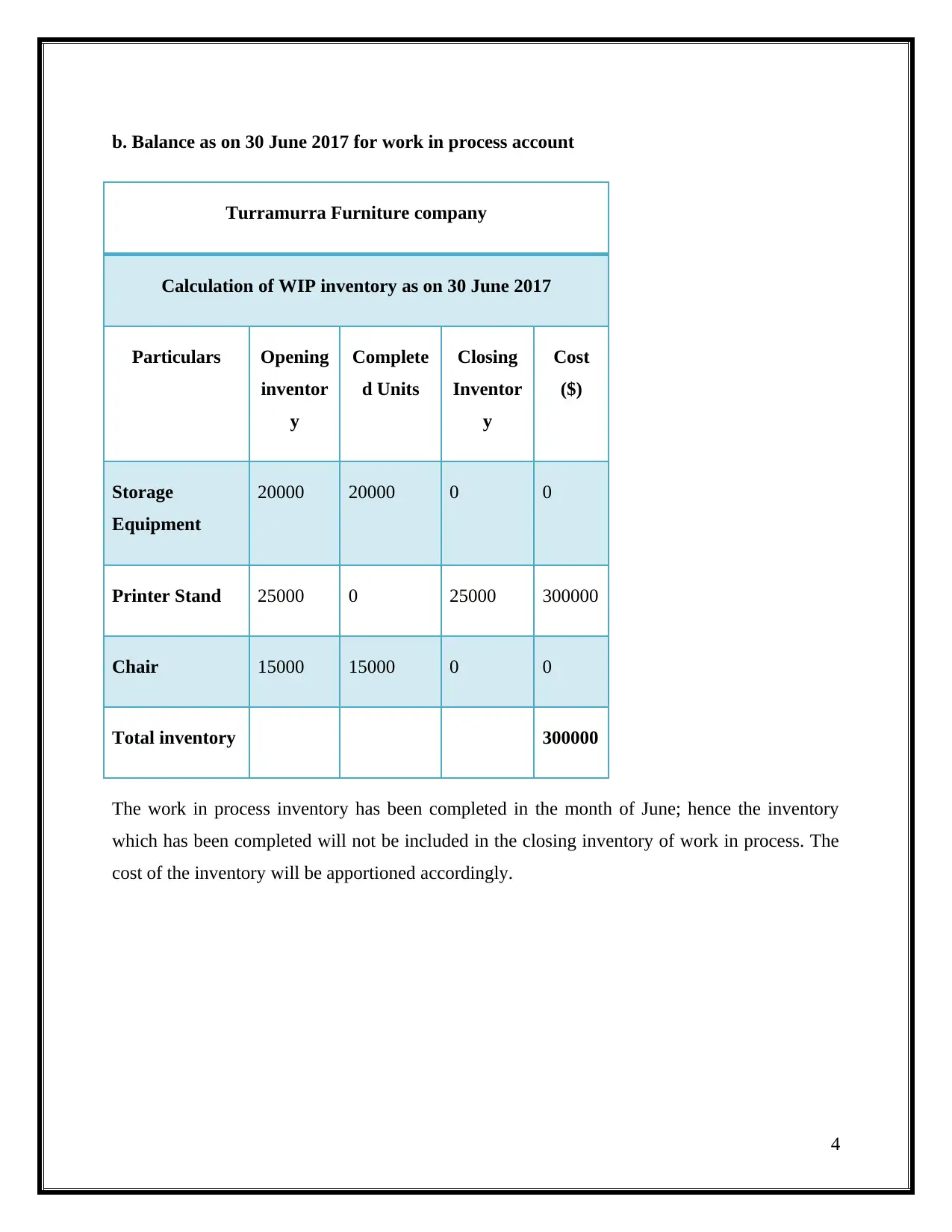
b. Balance as on 30 June 2017 for work in process account
Turramurra Furniture company
Calculation of WIP inventory as on 30 June 2017
Particulars Opening
inventor
y
Complete
d Units
Closing
Inventor
y
Cost
($)
Storage
Equipment
20000 20000 0 0
Printer Stand 25000 0 25000 300000
Chair 15000 15000 0 0
Total inventory 300000
The work in process inventory has been completed in the month of June; hence the inventory
which has been completed will not be included in the closing inventory of work in process. The
cost of the inventory will be apportioned accordingly.
4
Turramurra Furniture company
Calculation of WIP inventory as on 30 June 2017
Particulars Opening
inventor
y
Complete
d Units
Closing
Inventor
y
Cost
($)
Storage
Equipment
20000 20000 0 0
Printer Stand 25000 0 25000 300000
Chair 15000 15000 0 0
Total inventory 300000
The work in process inventory has been completed in the month of June; hence the inventory
which has been completed will not be included in the closing inventory of work in process. The
cost of the inventory will be apportioned accordingly.
4
Paraphrase This Document
Need a fresh take? Get an instant paraphrase of this document with our AI Paraphraser
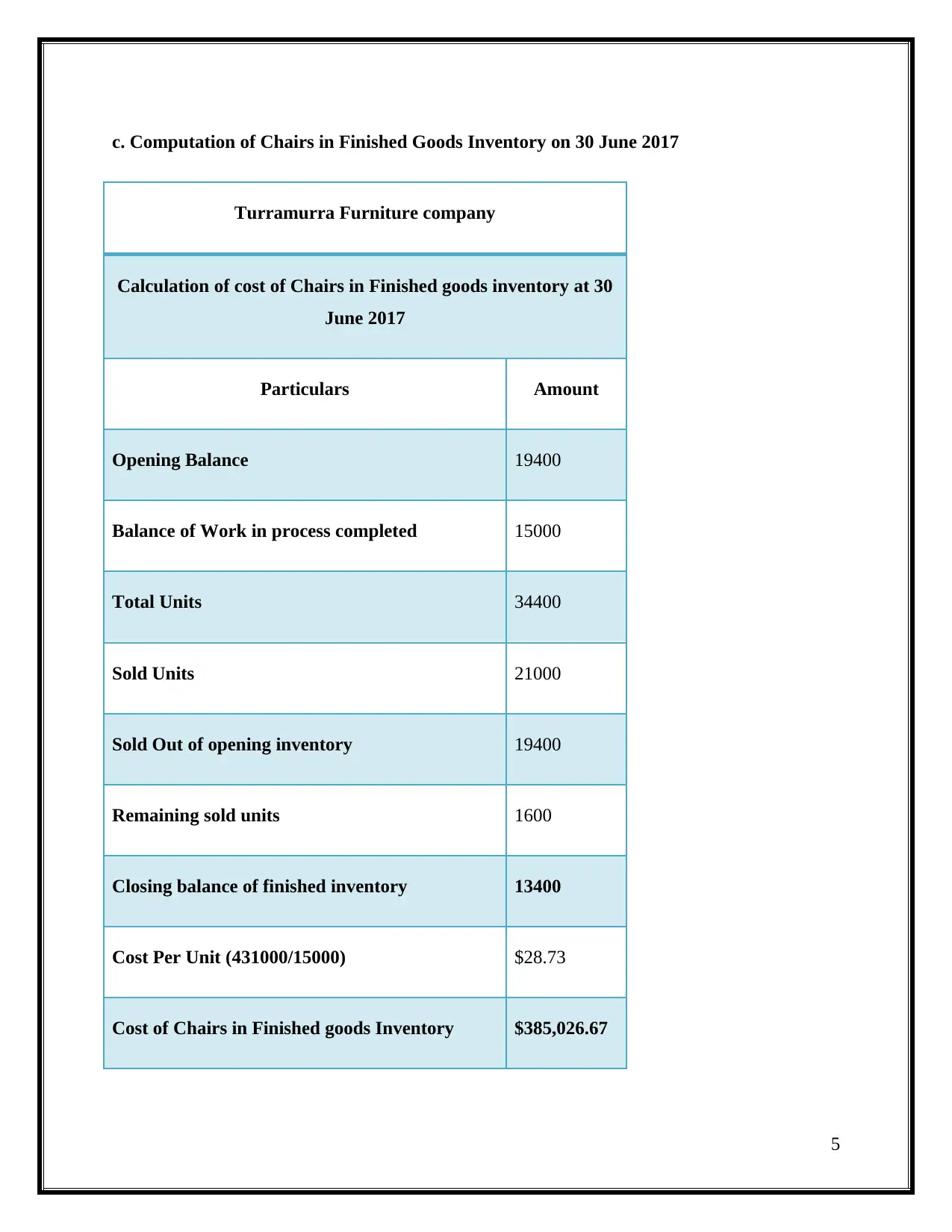
c. Computation of Chairs in Finished Goods Inventory on 30 June 2017
Turramurra Furniture company
Calculation of cost of Chairs in Finished goods inventory at 30
June 2017
Particulars Amount
Opening Balance 19400
Balance of Work in process completed 15000
Total Units 34400
Sold Units 21000
Sold Out of opening inventory 19400
Remaining sold units 1600
Closing balance of finished inventory 13400
Cost Per Unit (431000/15000) $28.73
Cost of Chairs in Finished goods Inventory $385,026.67
5
Turramurra Furniture company
Calculation of cost of Chairs in Finished goods inventory at 30
June 2017
Particulars Amount
Opening Balance 19400
Balance of Work in process completed 15000
Total Units 34400
Sold Units 21000
Sold Out of opening inventory 19400
Remaining sold units 1600
Closing balance of finished inventory 13400
Cost Per Unit (431000/15000) $28.73
Cost of Chairs in Finished goods Inventory $385,026.67
5
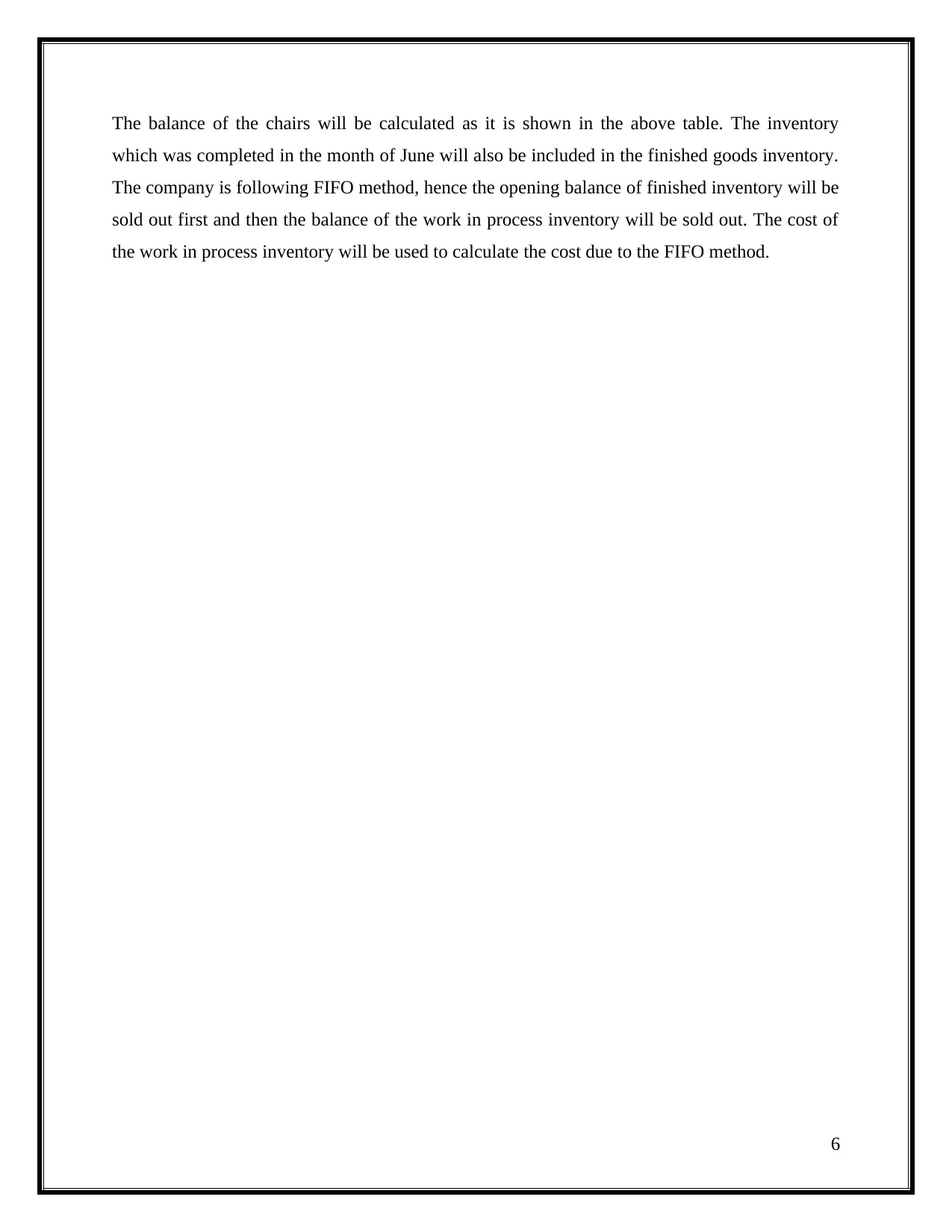
The balance of the chairs will be calculated as it is shown in the above table. The inventory
which was completed in the month of June will also be included in the finished goods inventory.
The company is following FIFO method, hence the opening balance of finished inventory will be
sold out first and then the balance of the work in process inventory will be sold out. The cost of
the work in process inventory will be used to calculate the cost due to the FIFO method.
6
which was completed in the month of June will also be included in the finished goods inventory.
The company is following FIFO method, hence the opening balance of finished inventory will be
sold out first and then the balance of the work in process inventory will be sold out. The cost of
the work in process inventory will be used to calculate the cost due to the FIFO method.
6
⊘ This is a preview!⊘
Do you want full access?
Subscribe today to unlock all pages.

Trusted by 1+ million students worldwide
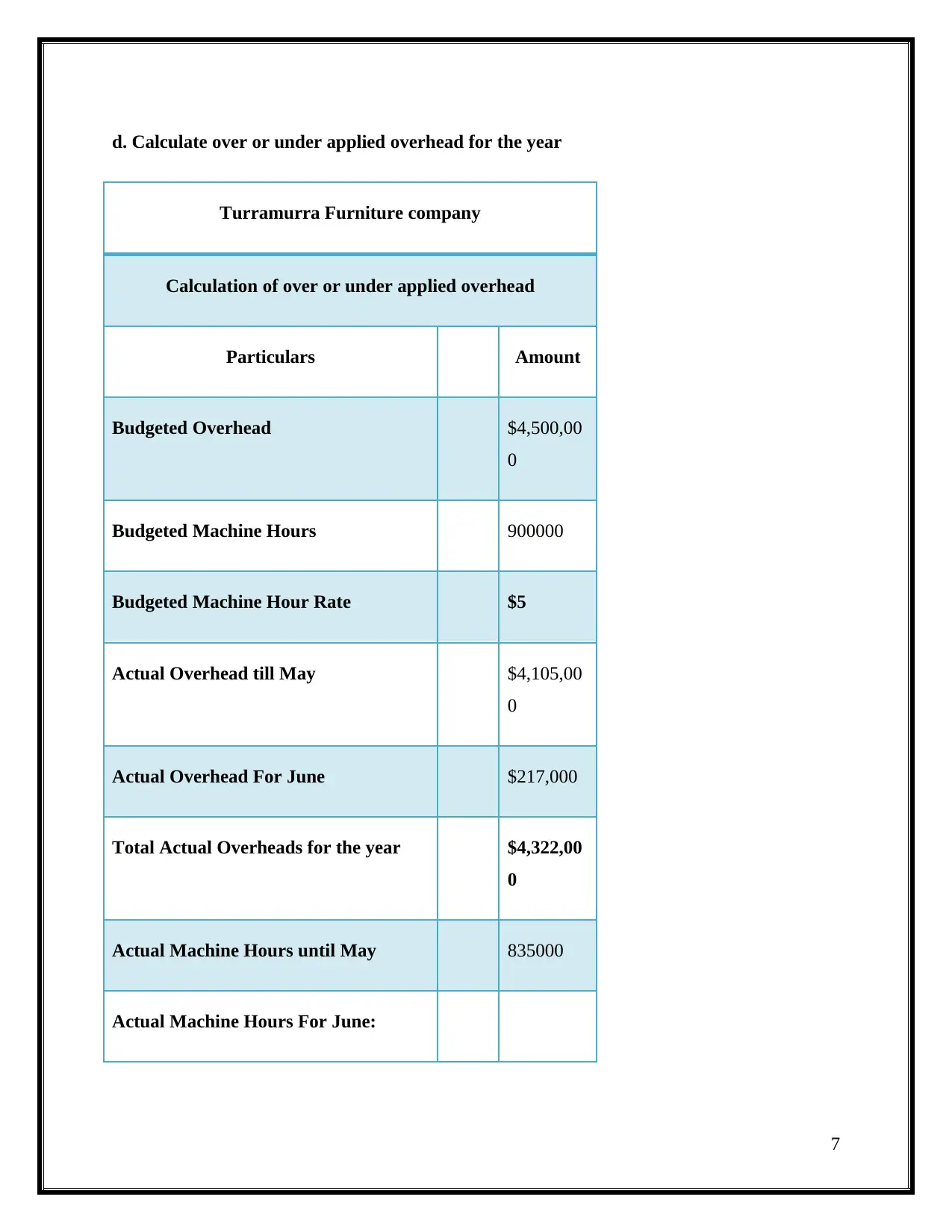
d. Calculate over or under applied overhead for the year
Turramurra Furniture company
Calculation of over or under applied overhead
Particulars Amount
Budgeted Overhead $4,500,00
0
Budgeted Machine Hours 900000
Budgeted Machine Hour Rate $5
Actual Overhead till May $4,105,00
0
Actual Overhead For June $217,000
Total Actual Overheads for the year $4,322,00
0
Actual Machine Hours until May 835000
Actual Machine Hours For June:
7
Turramurra Furniture company
Calculation of over or under applied overhead
Particulars Amount
Budgeted Overhead $4,500,00
0
Budgeted Machine Hours 900000
Budgeted Machine Hour Rate $5
Actual Overhead till May $4,105,00
0
Actual Overhead For June $217,000
Total Actual Overheads for the year $4,322,00
0
Actual Machine Hours until May 835000
Actual Machine Hours For June:
7
Paraphrase This Document
Need a fresh take? Get an instant paraphrase of this document with our AI Paraphraser
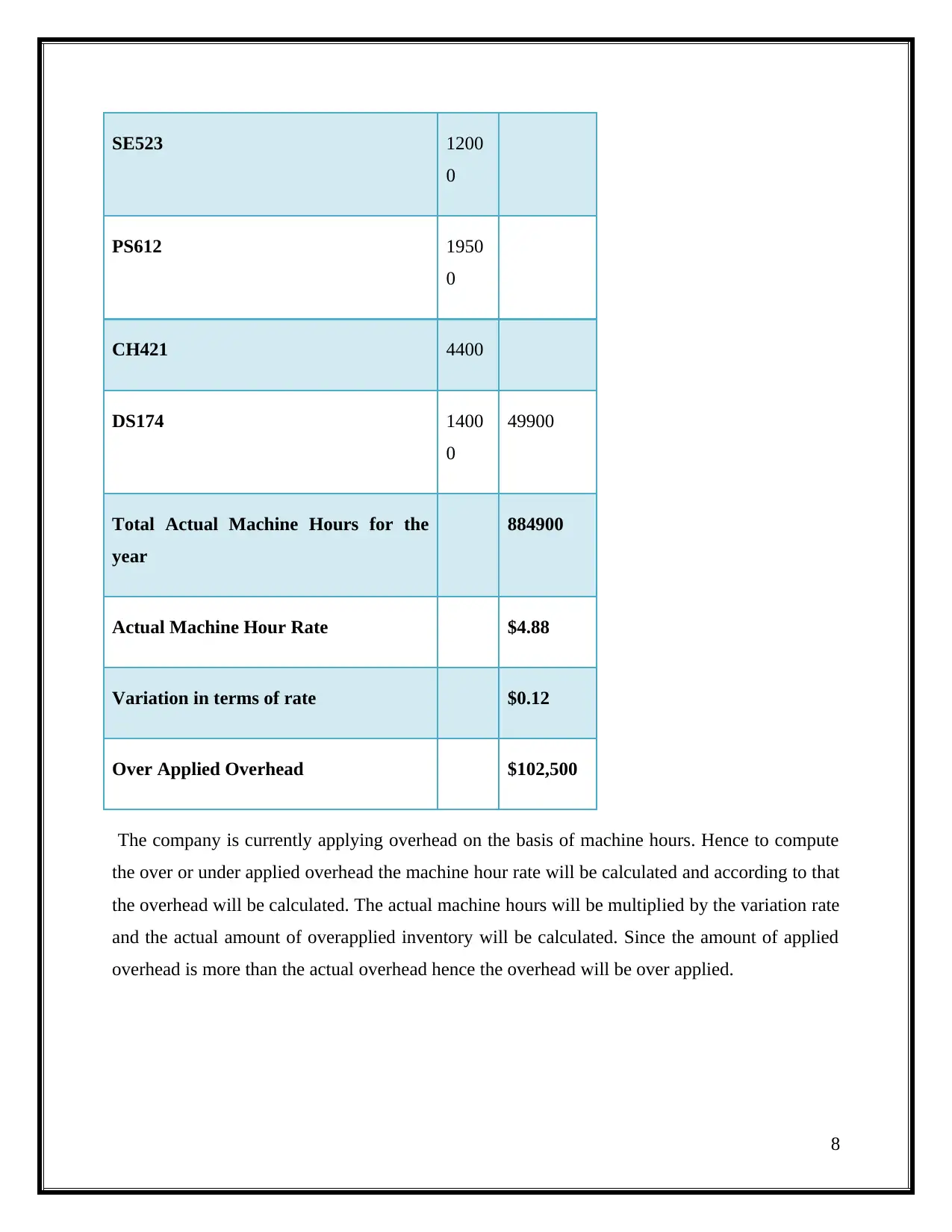
SE523 1200
0
PS612 1950
0
CH421 4400
DS174 1400
0
49900
Total Actual Machine Hours for the
year
884900
Actual Machine Hour Rate $4.88
Variation in terms of rate $0.12
Over Applied Overhead $102,500
The company is currently applying overhead on the basis of machine hours. Hence to compute
the over or under applied overhead the machine hour rate will be calculated and according to that
the overhead will be calculated. The actual machine hours will be multiplied by the variation rate
and the actual amount of overapplied inventory will be calculated. Since the amount of applied
overhead is more than the actual overhead hence the overhead will be over applied.
8
0
PS612 1950
0
CH421 4400
DS174 1400
0
49900
Total Actual Machine Hours for the
year
884900
Actual Machine Hour Rate $4.88
Variation in terms of rate $0.12
Over Applied Overhead $102,500
The company is currently applying overhead on the basis of machine hours. Hence to compute
the over or under applied overhead the machine hour rate will be calculated and according to that
the overhead will be calculated. The actual machine hours will be multiplied by the variation rate
and the actual amount of overapplied inventory will be calculated. Since the amount of applied
overhead is more than the actual overhead hence the overhead will be over applied.
8

e. Treatment for over applied of Overhead
The overhead which is applied is more than the actual overhead hence the overhead is over
applied. The over applied of inventory can be treated in two ways:
The over applied of inventory can be allocated among the cost of goods sold account
and inventory account i.e. finished goods, work in process and dispose it off.
The over applied of inventory can also be treated by allocating to the cost of goods
sold account and then dispose it off.
The above are the two treatments which can be used by the company if it has been following the
job order costing system. The company will then pass the accounting entries regarding the above
treatments and dispose off the manufacturing overhead that is over applied. The company will
allocate the amount of overapplied inventory in the proportionate amount (Chiang, 2013).
9
The overhead which is applied is more than the actual overhead hence the overhead is over
applied. The over applied of inventory can be treated in two ways:
The over applied of inventory can be allocated among the cost of goods sold account
and inventory account i.e. finished goods, work in process and dispose it off.
The over applied of inventory can also be treated by allocating to the cost of goods
sold account and then dispose it off.
The above are the two treatments which can be used by the company if it has been following the
job order costing system. The company will then pass the accounting entries regarding the above
treatments and dispose off the manufacturing overhead that is over applied. The company will
allocate the amount of overapplied inventory in the proportionate amount (Chiang, 2013).
9
⊘ This is a preview!⊘
Do you want full access?
Subscribe today to unlock all pages.

Trusted by 1+ million students worldwide
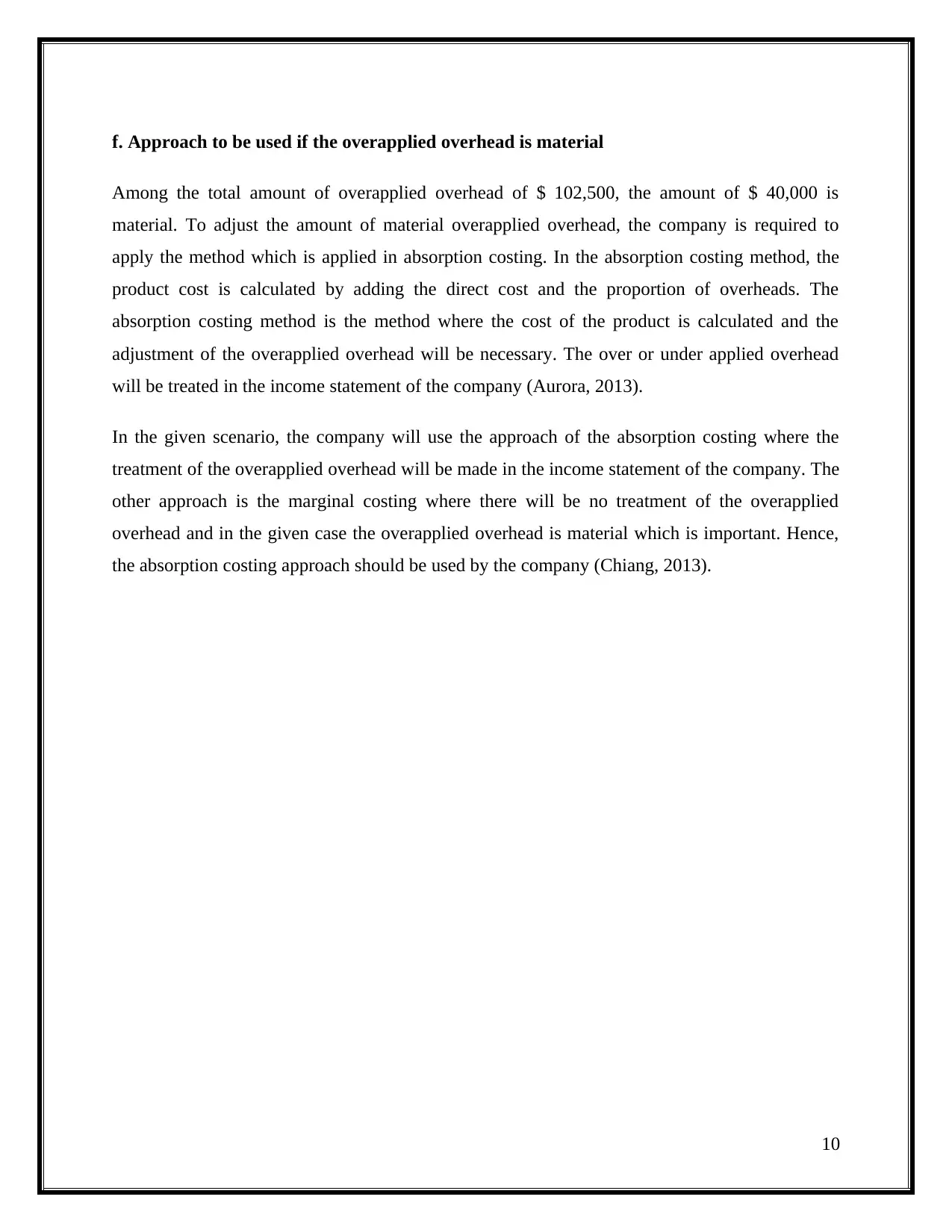
f. Approach to be used if the overapplied overhead is material
Among the total amount of overapplied overhead of $ 102,500, the amount of $ 40,000 is
material. To adjust the amount of material overapplied overhead, the company is required to
apply the method which is applied in absorption costing. In the absorption costing method, the
product cost is calculated by adding the direct cost and the proportion of overheads. The
absorption costing method is the method where the cost of the product is calculated and the
adjustment of the overapplied overhead will be necessary. The over or under applied overhead
will be treated in the income statement of the company (Aurora, 2013).
In the given scenario, the company will use the approach of the absorption costing where the
treatment of the overapplied overhead will be made in the income statement of the company. The
other approach is the marginal costing where there will be no treatment of the overapplied
overhead and in the given case the overapplied overhead is material which is important. Hence,
the absorption costing approach should be used by the company (Chiang, 2013).
10
Among the total amount of overapplied overhead of $ 102,500, the amount of $ 40,000 is
material. To adjust the amount of material overapplied overhead, the company is required to
apply the method which is applied in absorption costing. In the absorption costing method, the
product cost is calculated by adding the direct cost and the proportion of overheads. The
absorption costing method is the method where the cost of the product is calculated and the
adjustment of the overapplied overhead will be necessary. The over or under applied overhead
will be treated in the income statement of the company (Aurora, 2013).
In the given scenario, the company will use the approach of the absorption costing where the
treatment of the overapplied overhead will be made in the income statement of the company. The
other approach is the marginal costing where there will be no treatment of the overapplied
overhead and in the given case the overapplied overhead is material which is important. Hence,
the absorption costing approach should be used by the company (Chiang, 2013).
10
Paraphrase This Document
Need a fresh take? Get an instant paraphrase of this document with our AI Paraphraser
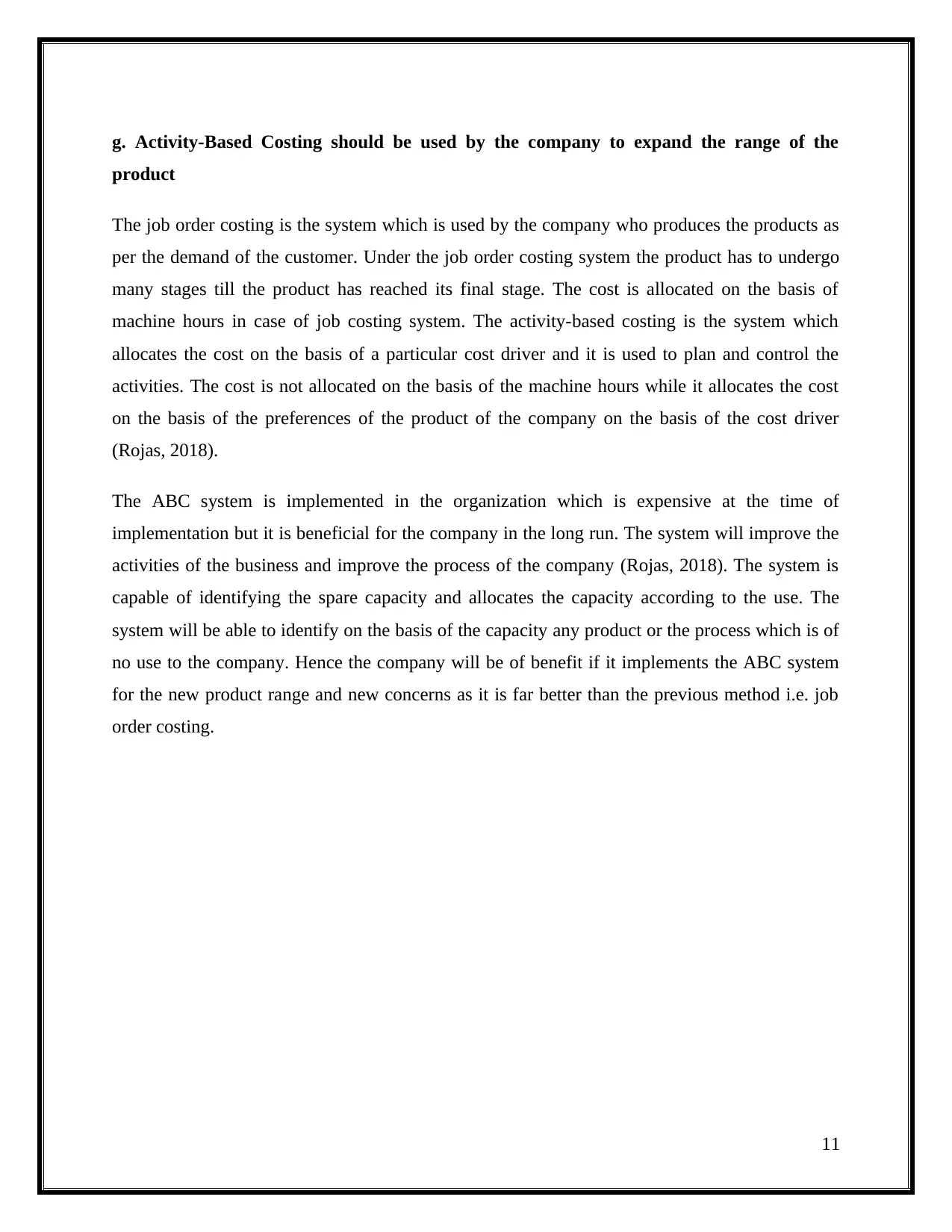
g. Activity-Based Costing should be used by the company to expand the range of the
product
The job order costing is the system which is used by the company who produces the products as
per the demand of the customer. Under the job order costing system the product has to undergo
many stages till the product has reached its final stage. The cost is allocated on the basis of
machine hours in case of job costing system. The activity-based costing is the system which
allocates the cost on the basis of a particular cost driver and it is used to plan and control the
activities. The cost is not allocated on the basis of the machine hours while it allocates the cost
on the basis of the preferences of the product of the company on the basis of the cost driver
(Rojas, 2018).
The ABC system is implemented in the organization which is expensive at the time of
implementation but it is beneficial for the company in the long run. The system will improve the
activities of the business and improve the process of the company (Rojas, 2018). The system is
capable of identifying the spare capacity and allocates the capacity according to the use. The
system will be able to identify on the basis of the capacity any product or the process which is of
no use to the company. Hence the company will be of benefit if it implements the ABC system
for the new product range and new concerns as it is far better than the previous method i.e. job
order costing.
11
product
The job order costing is the system which is used by the company who produces the products as
per the demand of the customer. Under the job order costing system the product has to undergo
many stages till the product has reached its final stage. The cost is allocated on the basis of
machine hours in case of job costing system. The activity-based costing is the system which
allocates the cost on the basis of a particular cost driver and it is used to plan and control the
activities. The cost is not allocated on the basis of the machine hours while it allocates the cost
on the basis of the preferences of the product of the company on the basis of the cost driver
(Rojas, 2018).
The ABC system is implemented in the organization which is expensive at the time of
implementation but it is beneficial for the company in the long run. The system will improve the
activities of the business and improve the process of the company (Rojas, 2018). The system is
capable of identifying the spare capacity and allocates the capacity according to the use. The
system will be able to identify on the basis of the capacity any product or the process which is of
no use to the company. Hence the company will be of benefit if it implements the ABC system
for the new product range and new concerns as it is far better than the previous method i.e. job
order costing.
11
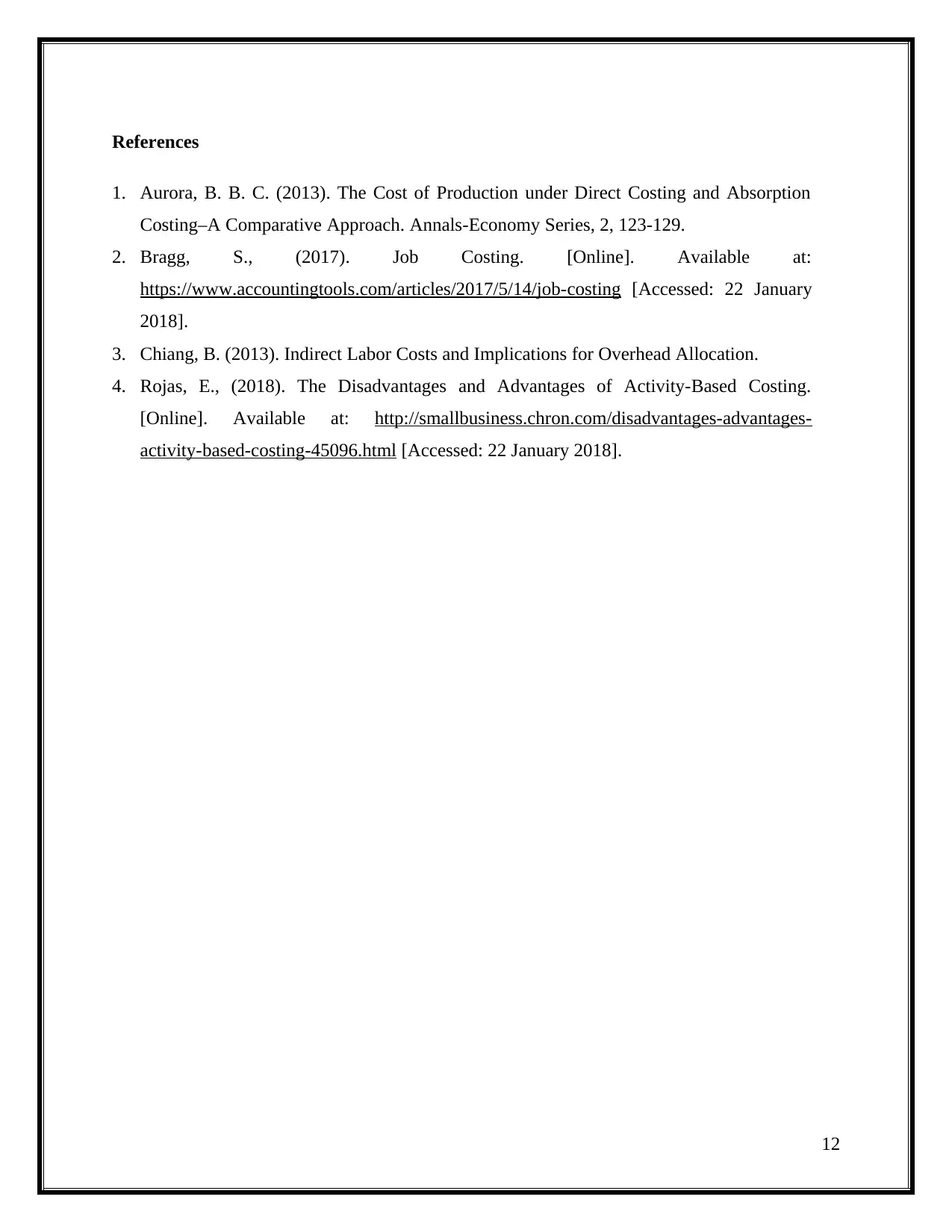
References
1. Aurora, B. B. C. (2013). The Cost of Production under Direct Costing and Absorption
Costing–A Comparative Approach. Annals-Economy Series, 2, 123-129.
2. Bragg, S., (2017). Job Costing. [Online]. Available at:
https://www.accountingtools.com/articles/2017/5/14/job-costing [Accessed: 22 January
2018].
3. Chiang, B. (2013). Indirect Labor Costs and Implications for Overhead Allocation.
4. Rojas, E., (2018). The Disadvantages and Advantages of Activity-Based Costing.
[Online]. Available at: http://smallbusiness.chron.com/disadvantages-advantages-
activity-based-costing-45096.html [Accessed: 22 January 2018].
12
1. Aurora, B. B. C. (2013). The Cost of Production under Direct Costing and Absorption
Costing–A Comparative Approach. Annals-Economy Series, 2, 123-129.
2. Bragg, S., (2017). Job Costing. [Online]. Available at:
https://www.accountingtools.com/articles/2017/5/14/job-costing [Accessed: 22 January
2018].
3. Chiang, B. (2013). Indirect Labor Costs and Implications for Overhead Allocation.
4. Rojas, E., (2018). The Disadvantages and Advantages of Activity-Based Costing.
[Online]. Available at: http://smallbusiness.chron.com/disadvantages-advantages-
activity-based-costing-45096.html [Accessed: 22 January 2018].
12
⊘ This is a preview!⊘
Do you want full access?
Subscribe today to unlock all pages.

Trusted by 1+ million students worldwide
1 out of 12
Related Documents
Your All-in-One AI-Powered Toolkit for Academic Success.
+13062052269
info@desklib.com
Available 24*7 on WhatsApp / Email
![[object Object]](/_next/static/media/star-bottom.7253800d.svg)
Unlock your academic potential
Copyright © 2020–2025 A2Z Services. All Rights Reserved. Developed and managed by ZUCOL.





